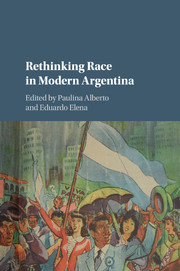Book contents
- Frontmatter
- Contents
- List of figures
- List of tables
- Notes on the contributors
- Preface
- Introduction: The shades of the nation
- PART I HISTORIES OF RACE IN THE TWENTIETH CENTURY
- PART II RACE AND NATION IN THE NEW CENTURY
- 8 African descent and whiteness in Buenos Aires: Impossible mestizajes in the white capital city
- 9 The savage outside of White Argentina
- 10 Between foreigners and heroes: Asian-Argentines in a multicultural nation
- 11 Indias blancas, negros febriles: Racial stories and history-making in contemporary Argentine fiction
- Epilogue: Whiteness and its discontents
- Collective bibliography
- Index
8 - African descent and whiteness in Buenos Aires: Impossible mestizajes in the white capital city
from PART II - RACE AND NATION IN THE NEW CENTURY
Published online by Cambridge University Press: 05 March 2016
- Frontmatter
- Contents
- List of figures
- List of tables
- Notes on the contributors
- Preface
- Introduction: The shades of the nation
- PART I HISTORIES OF RACE IN THE TWENTIETH CENTURY
- PART II RACE AND NATION IN THE NEW CENTURY
- 8 African descent and whiteness in Buenos Aires: Impossible mestizajes in the white capital city
- 9 The savage outside of White Argentina
- 10 Between foreigners and heroes: Asian-Argentines in a multicultural nation
- 11 Indias blancas, negros febriles: Racial stories and history-making in contemporary Argentine fiction
- Epilogue: Whiteness and its discontents
- Collective bibliography
- Index
Summary
M. Mujica Lainez: Were all of our black people killed off during the war with Paraguay? When did they disappear?
J.L. Borges: I can say something based on personal experience. In 1910 or 1912 it was common to see black people […] They were not killed off in our frontier wars nor in the Paraguayan war; but what happened to them later, I can't say […]
M. Mujica Lainez: It's possible that their color faded [puede ser que se hayan desteñido], and that many of the whites that we know are blacks.
Manuel Mujica Lainez, Los porteños (1980), 27.In 1881, José Antonio Wilde – a renowned intellectual and doctor from the capital city of Buenos Aires – published his memoirs, Buenos Aires desde setenta años atrás, which would become a leading primary source for the study of the early post-independence period in the Argentine capital. Wilde portrayed the “mulatto” J. Antonio Viera, a celebrated nineteenth-century actor and singer, as follows: “His courteous demeanor and his manners left nothing to be desired, and as the saying goes, only his color was lacking [el color no más le faltaba], or more accurately, he had an excess of it.” In 2010, more than a hundred and thirty years after Wilde's book was first published, Paula, a porteña (or resident of Buenos Aires city) who self-identifies as an Afro-descendant, said of herself in an interview: “Only my color is lacking [a mí me falta el color nada más].”
The extraordinary formal similarity between these two testimonies points to the historical persistence of a troubling relationship among perceived skin color, a supposedly expected “way of being,” and the (im)possibility of recognition and self-recognition within established social categories. For what does it mean for someone to lack or to have an excess of color? In regard to what standard is someone's skin color judged to be too much or too little? This verdict implies, among many other things, that there is something in that person – whether a “mulatto” or an “Afro-descendant” – that exceeds or does not fit into established social categories. In this chapter, I will explore this conceptual dislocation between appearances and ways of being, which, I argue, must be understood in relation to the absence of intermediate or mixed (mestizo) categories in Buenos Aires.
- Type
- Chapter
- Information
- Rethinking Race in Modern Argentina , pp. 213 - 240Publisher: Cambridge University PressPrint publication year: 2016
- 21
- Cited by



